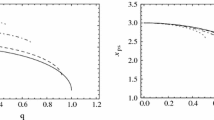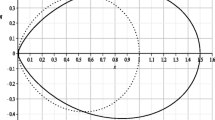Abstract
In nonlinear electrodynamics a photon does not follow null geodesics of background geometry, but moves along null geodesics of a corresponding effective geometry. Therefore, in the strong deflection limit, in order to study the gravitational lensing of the regular electrically charged black holes obtained by coupling general relativity to nonlinear electrodynamics, one should firstly obtain the corresponding effective geometry, which is a necessary and key step. I obtain the deflection angle of the photon in the strong deflection limit, and further calculate the angular position and magnification of relativistic images. It is found that, the electric charge has significant effect on the gravitational lensing of regular black holes. With the increase of the electric charge q, the angular position of the relativistic images \(\theta _{\infty }\) and the relative magnification \(\mathcal {R}_{m}\) as a function of q decrease, while the angular separation between the outermost relativistic image and the others \(\mathcal {S}\) as a function of q increases. I also discuss the measurement of observables for the black hole at the center of our Galaxy in the cases of regular electrically charged black hole effective metrics.




Similar content being viewed by others
Notes
There exists a general consensus that astrophysical black holes with large amounts of charge can not exist in nature since astrophysical black holes are always surrounded by some plasma which is a very good conductor, consequently the electric charge of them would be significantly reduced shortly by interaction with the surrounding plasma [43,44,45]. However, this point of view has been challenged. Some researchers found that the electrically charged black hole can be formed during electrically charged stellar collapse or accreting process of a neutral black hole [30, 44,45,46,47,48].
References
Bardeen, J.: Presented at GR5, Tiflis, U.S.S.R., and Published in the Conference Proccedings in the U.S.S.R. (1968)
Ayón-Beato, E., García, A.: Phys. Lett. B 493, 149 (2000)
Ayón-Beato, E., García, A.: Phys. Rev. Lett. 80, 5056 (1998)
Ayón-Beato, E., García, A.: Phys. Lett. B 464, 25 (1999)
Ayón-Beato, E., García, A.: Gen. Relativ. Gravit. 31, 629 (1999)
Bronnikov, K.A.: Phys. Rev. D 63, 044005 (2001)
Dymnikova, I.: Class. Quantum Grav. 21, 4417 (2004)
Bronnikov, K.A., Fabris, J.C.: Phys. Rev. Lett. 96, 251101 (2006)
Bambi, C., Modesto, L.: Phys. Lett. B 721, 329 (2013)
Balart, L., Vagenas, E.C.: Phys. Lett. B 730, 14 (2014)
Balart, L., Vagenas, E.C.: Phys. Rev. D 90, 124045 (2014)
Nicolini, P., Smailagic, A., Spallucci, E.: Phys. Lett. B 632, 547 (2006)
Ansoldi, S., et al.: Phys. Lett. B 645, 261 (2007)
Nicolini, P.: Int. J. Mod. Phys. A 24, 1229 (2009)
Ansoldi S.: arXiv:0802.0330
Bozza, V.: Phys. Rev. D 66, 103001 (2002)
Bozza, V., et al.: Gen. Relativ. Gravit. 33, 1535 (2001)
Eiroa, E.F., Sendra, C.M.: Class. Quantum Grav. 28, 085008 (2011)
Eiroa, E.F., Sendra, C.M.: Phys. Rev. D 86, 083009 (2012)
Eiroa, E.F., Sendra, C.M.: Phys. Rev. D 88, 103007 (2013)
Eiroa, E.F.: Eur. Phys. J. C 74, 3171 (2014)
Whisker, R.: Phys. Rev. D 71, 064004 (2005)
Majumdar, A.S., Mukherjee, N.: Int. J. Mod. Phys. D. 14, 1095 (2005)
Eiroa, E.F., Sendra, C.M.: Phys. Rev. D 71, 083010 (2005)
Eiroa, E.F.: Phys. Rev. D 73, 043002 (2006)
Zhao, S.-S., Xie, Y.: JCAP 07, 007 (2016)
Chen, S., Jing, J.: Phys. Rev. D 80, 024036 (2009)
Cheng, H., Man, J.: Class. Quantum Grav. 28, 015001 (2011)
Ding, C., Kang, S., Chen, C.-Y.: Phys. Rev. D 83, 084005 (2011)
Ding, C., Jing, J.: JHEP 10, 052 (2011)
Ding, C., et al.: Phys. Rev. D 88, 104007 (2013)
Tsukamoto, N., et al.: Phys. Rev. D 90, 064043 (2014)
Wei, S.W., Yang, K., Liu, Y.-X.: Eur. Phys. J. C 75, 253 (2015)
Sotani, H., Miyamoto, U.: Phys. Rev. D 92, 044052 (2015)
Wei, S.W., Liu, Y.X., Fu, C.E.: Adv. High Energy Phys. 2015, 454217 (2015)
Bhadra, A.: Phys. Rev. D 67, 103009 (2003)
Sarkar, K., Bhadra, A.: Class. Quantum Grav. 23, 6101 (2006)
Mukherjee, N., Majumdar, A.S.: Gen. Relativ. Gravit. 39, 583 (2007)
Ghosh, T., SenGupta, S.: Phys. Rev. D 81, 044013 (2010)
Gyulchev, G.N., Stefanov, IZh: Phys. Rev. D 87, 063005 (2013)
Liang, J.: Chin. Phys. Lett. 34, 050401 (2017)
Liang, J.: Commun. Theor. Phys. 67, 407 (2017)
Narayan, R.: New J. Phys. 7, 199 (2005)
Ghezzi, G.R.: Phys. Rev. D 72, 104017 (2005)
Baushev, A.S., Chardonnet, P.: Int. J. Mod. Phys. D 18, 2035 (2000)
Ghezzi, G.R., Letelier, P.S.: Phys. Rev. D 75, 024020 (2007)
Ruffini, R., et al.: Astron. Astrophys. 350, 334 (1999)
Cuesta, H.J.M., Penna-Firme, A., Pérez-Lorenzana, A.: Phys. Rev. D 67, 087702 (2003)
Gatiérrez, S.A., Dudley, A., Plebańsky, J.: J. Math. Phys. 22, 2835 (1981)
Novello, M., et al.: Phys. Rev. D 61, 045001 (2000)
Novello, M., Perez Bergliaffa, S.E., Salim, J.M.: Class. Quantum Grav. 17, 3821 (2000)
Mosquera Cuesta, H.J., de Freitas, Pacheo J.A., Salim, J.M.: Int. J. Mod. Phys. A 21, 43 (2006)
Ghaffarnejad H., Mojahedi M.A., Niad H.: arXiv:1601.05749
Salazar, I.H., Garcia, A., Plebańsky, J.: J. Math. Phys. 28, 2171 (1987)
Carter, B.: Phys. Rev. 174, 1559 (1968)
Hawking, S.W., Ellis, G.F.R.: The Large Scale Structure of Space-Time. Cambridge University Press, Cambridge (1973)
Weinberg, S.: Gravitation and Cosmology: Principles and Applications of the General Theory of Relativity. Wiley, New York (1972)
Virbhadra, K.S., Narasimha, D., Chitre, S.M.: Astron. Astrophys. 337, 1 (1998)
Virbhadra, K.S., Ellis, G.F.R.: Phys. Rev. D 62, 084003 (2000)
Claudel, C.-M., Virbhadra, K.S., Ellis, G.F.R.: J. Math. Phys. 42, 818 (2001)
Virbhadra, K.S., Ellis, G.F.R.: Phys. Rev. D 65, 103004 (2002)
Gillessen, S., et al.: Astrophys. J. Lett. 707, L114 (2009)
Acknowledgements
This work was supported by the Natural Science Foundation of Education Department of Shannxi Province under Grant No. 15JK1077 and by the Doctorial Scientific Research Starting Fund of Shannxi University of Science and Technology under Grant No. BJ12-02.
Author information
Authors and Affiliations
Corresponding author
Appendix A: Calculation of the deflection angle in the SDL
Appendix A: Calculation of the deflection angle in the SDL
The integral \(I(x_{0})\) becomes
where
Here, it should be stressed that the functions without the subscript 0, A(x), B(x) and C(x) are evaluated at \(x=\frac{x_{0}}{1-z}\). \(R(z,x_{0})\) is regular for all values of z and \(x_{0}\), while \(f(z,x_{0})\) is divergent for \(z\rightarrow 0\). In order to find the order of the divergence of (45), we expand the argument of the square root in \(f(z,x_{0})\) to the second order in z:
where
(49) clearly shows that \(\zeta \) vanishes at \(x_{0}=x_{m}\), so \(f(z,x_{0})\propto \frac{1}{z}\) and \(I(x_{0})\) (and consequently the deflection angle \(\alpha (x_{0})\)) diverges logarithmically. Then, following Ref. [16], we split (45) into two pieces
where \(I_{D}(x_{0})\) is divergent, while \(I_{R}(x_{0})\) is regular. They are
where
\(I_{D}(x_{0})\) can be evaluated exactly as
We further expand \(\zeta \) in powers of \((x_{0}-x_{m})\), getting
where
Substituting (56) and (57) into (55), we get
where
We can also expand \(g(z,x_{0})\) in powers of \((x_{0}-x_{m})\) to get
Substituting (61) into (53), and just retaining the \(n=0\) term, leads to
Expanding (20), we get
where the coefficient \(c_{2}\) is
Using (63), (64) and \(\theta \approx \frac{u}{D_{OL}}\), we can finally express the deflection angle as a function of \(\theta \) as
where
where \(b_{R}\) is defined as
[See (62)].
Rights and permissions
About this article
Cite this article
Liang, J. Strong gravitational lensing by regular electrically charged black holes. Gen Relativ Gravit 49, 137 (2017). https://doi.org/10.1007/s10714-017-2307-7
Received:
Accepted:
Published:
DOI: https://doi.org/10.1007/s10714-017-2307-7




